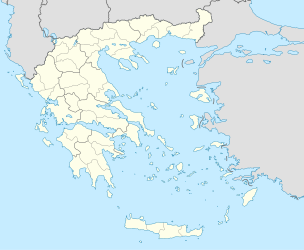SS Letchworth (1942)
 From Wikipedia - Reading time: 7 min
From Wikipedia - Reading time: 7 min
| History | |
|---|---|
| Name |
|
| Owner |
|
| Operator |
|
| Port of registry | |
| Builder | William Gray & Co. Ltd. |
| Launched | 31 March 1942 |
| Completed | May 1942 |
| Out of service | 31 March 1967 |
| Identification |
|
| Fate | Sank, 1 April 1967. |
| General characteristics | |
| Tonnage | |
| Length | 315 ft 4 in (96.11 m) |
| Beam | 46 ft 5 in (14.15 m) |
| Depth | 23 ft 0 in (7.01 m) |
| Installed power | Triple expansion steam engine |
| Propulsion | Screw propeller |
Letchworth was a 2,873 GRT cargo ship which was built in 1942 for the Ministry of War Transport (MoWT) as Empire Caxton. In 1945 she was sold and renamed Letchworth. In 1956 she was sold and renamed Peterland. In 1959, she was sold to Greece and renamed Pamit, being renamed Christos when sold again in 1962. She served until 1967 when she ran aground and then sank.
Description
[edit]The ship was built by William Gray & Co. Ltd., West Hartlepool. She was launched on 31 March 1942 and completed in May.[1]
The ship was 315 feet 4 inches (96.11 m) long, with a beam of 46 feet 5 inches (14.15 m) and a depth of 23 feet 0 inches (7.01 m). She had a GRT of 2,873 and a NRT of 1,693.[2]
She was propelled by a triple expansion steam engine, which had cylinders of 20 inches (51 cm), 31 inches (79 cm) and 55 inches (140 cm) diameter by 55 inches (140 cm) stroke. The engine was built by the Central Marine Engine Works, West Hartlepool.[2]
History
[edit]Empire Caxton was built for the MoWT. She was placed under the management of Martyn, Martyn & Co Ltd. She was allocated the United Kingdom Official Number 168940. The Code Letters BDVW were allocated and her port of registry was West Hartlepool.[2]
Empire Caxton was a member of a number of convoys during the Second World War.
- SC 141
Convoy SC 141 departed Halifax, Nova Scotia on 3 September 1943 and arrived at Liverpool on 17 September. Empire Cavalier was carrying a cargo of steel and pit props and was bound for the Tyne.[3]
- MKS 64
Convoy MKS 64 departed from Alexandria, Egypt on 7 October 1944 bound for the United Kingdom. Empire Caxton joined the convoy at Augusta, Italy and left it at Gibraltar.[4]
- MKS 65G
Convoy MKS 65G departed Gibraltar on 29 October 1944 bound for the United Kingdom. Empire Caxton was carrying a cargo of iron ore.[4]
- MKS 73G
Convoy MKS 73G departed Gibraltar on 26 December 1944 bound for the United Kingdom. Empire Caxton was carrying a cargo of iron ore.[4]
- MKS 87G
Convoy MKS 87G departed Casablanca, Morocco on 6 March 1945 bound for the United Kingdom. Empire Caxton was carrying a cargo of iron ore.[4]
- MKS 100G
Convoy MKS 100G joined convoy OS 128 on 15 May 1945. Empire Caxton was carrying a cargo of iron ore.[4]
In 1945, Empire Caxton was sold to the Watergate Steamship Co Ltd, Newcastle upon Tyne and was renamed Letchworth. She was placed under the management of R S Dalgleish Ltd, Newcastle upon Tyne.[1] Her port of registry was changed to Newcastle upon Tyne.[5] In 1956, Letchworth was sold to Sagaland Ltd and was renamed Peterland. She was operated under the management of Buries, Markes LTd.[1] In 1959, Peterland was sold to Padre Compagnia Navigazione SA, Greece and renamed Pamit. She was operated under the management of A Halcoussis & Co.[1]
In 1962, Pamit was sold to Solmare Compania Maritima SA and was renamed Christos.[1] She was reflagged to Liberia.[6] Christos was operated under the management on T Samourkas, Greece. On 31 March 1967, she ran aground on Kandeliusa Island, near Kos. Although she was refloated the next day, Christos developed a number of leaks and sank at 36°32′N 26°57′E / 36.533°N 26.950°E.[1]
References
[edit]- ^ a b c d e f Mitchell, W H, and Sawyer, L A (1995). The Empire Ships. London, New York, Hamburg, Hong Kong: Lloyd's of London Press Ltd. p. 197. ISBN 1-85044-275-4.
{{cite book}}: CS1 maint: multiple names: authors list (link) - ^ a b c "LLOYD'S REGISTER, STEAMERS & MOTORSHIPS" (PDF). Plimsoll Ship Data. Retrieved 17 March 2010.
- ^ "CONVOY SC 141". Warsailors. Retrieved 15 March 2010.
- ^ a b c d e "MKS Convoys – Nov. 1942-1945, MKS 61 through MKS 103". Warsailors. Retrieved 17 March 2010.
- ^ "LLOYD'S REGISTER, STEAMERS & MOTORSHIPS" (PDF). Plimsoll Ship Data. Retrieved 17 March 2010.
- ^ "Greek tragedy of the Letchworth". The Shields Gazette. Retrieved 17 March 2010.
 KSF
KSF